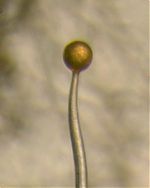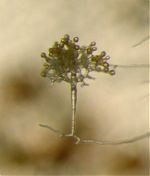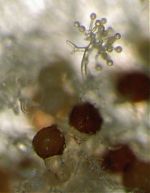Dicanophora
DICRANOPHORA Schröter, 1886 (Jahresbericht der Schlesischen Gesellschraft für vaterländicshe Cultur 64:84); 1 species (Voglmayr and Krisai-Greilhuber, 1996).
Dicanophora fulva produces multispored sporangia and unispored sporangia with the latter being formed on dichotomously branched sporangiophores. The mycelium is yellow when grown in culture. Zygospores are formed on opposed, heterogamous suspensors. The fungus is homothallic.
Type species: D. fulva
Species of Dicranophora:
D. fulva Schröter, 1886 (Jahresbericht der Schlesischen Gesellschraft für vaterländicshe Cultur 64:84).
Dicranophora is a parasite in nature of boletaceous basidiomycetes (_Boletus, Gomphidius, Paxillus_; Zycha et al., 1969) and Suillus (Voglmeyr and Krisai-Greihlhuber, 1996). This is very rare fungus that cannot be grown above 19 C and it may be overlooked because it forms a low turf on the host. Most reports of D. fulva were of collections made in Europe but this taxon has been found in northeastern North America (R. Thaxter collections at the Farlow herbarium [FH], Harvard University) and by Dr. R.D. Goos (Personal communication, May, 1988). Yong (1930-1931) and Dobbs (1938) also illustrated D. fulva.
Bibliography
Dobbs, C. G. 1938. The life history and morphology of Dicranophora fulva Schröt. Trans. Brit. Mycol. Soc. 21:167-192.
Yong (as Young), L. 1930-1931. Étude biologique des phénomènes de la sexualité chez les Mucorinées. Rev. Gen. Bot., Paris 42:205-218, 43:30-43.
Volgmayr, H., and I. Krisai-Greilhuber. 1996. Dicranophora fulva, a rare mucoraceous fungus growing on boletes. Mycol. Res. 100:583-590.
Updated Mar 14, 2005



